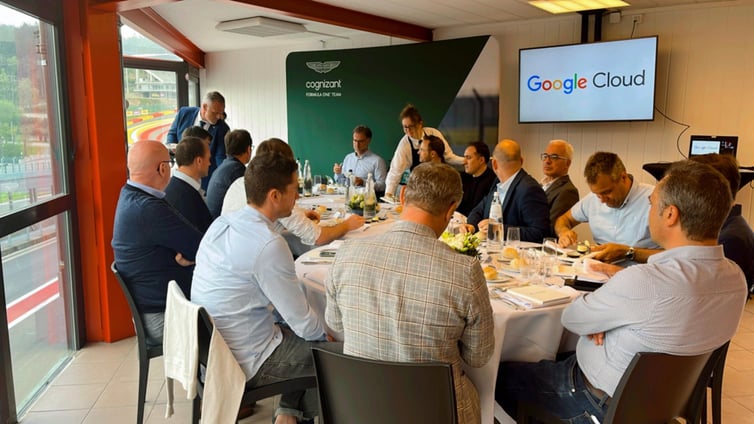

"Google’s mission is to bring the world’s data to you, to your PC, to your mobile phone", confirms Edward Boute, country manager Belgium of Google Cloud. Google remains committed to this mission, but is also taking the next step in using data and analytics to make the world a better place, among others, through the humanitarian and sustainability missions of X, Alphabet's Moonshot factory.
How mature is your organisation in its use of analytics?
On the question "How mature is your organisation in its current use of analytics" the eleven CIOs and CISOs at the roundtable provided answers that ranged from investigating and performing pilots to implementing and optimising well-established systems.
The CISOs at the table quite understandably viewed AI from a security angle. Rik Bobbaers, CISO at ING, is implementing AI to make their detection systems more intelligent, primarily to reduce false positives, a domain still under full development. Tom Gilis, peer CISO at UCB, confirms the potential of advanced analytics in this domain. However, being a pharma company implies that data has always been at the core of their operations, such as in drug development. This is why they have a mature, centralised, cloud-based data analytics environment. For Tom, this also means striking a critical balance between usability and security, making it user-friendly while keeping it secure.The CIOs of the banks present (ING, KBC, Belfius) claimed they rely on quite mature and advanced analytics systems. However, these systems are still heavily occupied with managing compliance and regulatory affairs. Only half of the capabilities are left to genuinely improve business performance, optimise customer experiences, fight fraud, or manage risks. Jonathan Neubourg, CDO at Belfius, confirms this preoccupation with compliance and reporting. "Thus, our interest in automating this part to the maximum to invest more time and energy in interesting use cases that can make a difference. We have to make the bank future-proof but at the same time deal with 'the shit of yesterday', to quote Peter Hinssen’s book1.
 "The world of HR has always been somewhat of a laggard in adopting new technologies", comments Jurgen De Jonghe of SDWorx. "So, our mission to introduce advanced data and analytics systems is not a given. Still, the current war for talent and the renewed focus on efficiency at the workplace is giving a new push' to the adoption of 'intelligent' systems.
"The world of HR has always been somewhat of a laggard in adopting new technologies", comments Jurgen De Jonghe of SDWorx. "So, our mission to introduce advanced data and analytics systems is not a given. Still, the current war for talent and the renewed focus on efficiency at the workplace is giving a new push' to the adoption of 'intelligent' systems.
In manufacturing environments, on the other hand, it is not surprising that the analytics capacities are firstly invested in achieving operational excellence at all levels of the manufacturing process, as to Christopher Franskin, Global Head of Digital Technology Transformation & Enablement at Solvay. This is a prime focus of the digital transformation of the company. Bart Kerckhofs, CIO of Bridgestone, confirms that the transition of Bridgestone from a traditional manufacturer (of tires and other products) to a provider of solutions and services (eg mobility solutions) came with a digital transformation towards a data-driven organisation, not only in terms of operational efficiency but also for innovation and the creation of new products and services. The big challenge now is how to democratise data and analytics and make it available and properly used by all levels within the organisation. The same goes for Vandemoortele, testifies Benoit Dewaele. "We have a cloud-based infrastructure where for security and performance AI is used. Bringing AI to the domain of manufacturing, quality control, and product development still requires evangelizing of our engineers who have a strong affinity with manufacturing execution systems, machines and hardware.” Timothy De ben , who is a CISO, next to IT Infra manager at DPD, the logistics company, shares that DPD has become a data company that also delivers parcels. Data and insights are driving operations: the organisation of the workforce, the fleet, the routes up and till the quality systems based on advanced computer vision systems to identify the parcels. But as to Timothy, "Although we have already transformed quite substantially, we notice that not all departments consume data on the same maturity level".

At Imec, the situation is different, as to Kris Maes. Imec designs and builds chips and, lately, also applications. Imec is involved in projects such as IoT for water, or digital twin cities. These solutions generate a lot of data, which are processed by very advanced systems. However, data and analytics are still in their early stage for internal use. They are now launching use cases, mainly in the field of R&D.
The ten commandments
After this first assessment, we gave the floor to Dimitar Yaprakov, Lead Data Scientist, at KBC who provided a high-level view of KBC's vision on data and analytics in the form of ten commandments.
When asked how he calculates the ROI on his team’s work, Dimitar responded by saying that the bottleneck does not lie within his team. For two reasons: firstly, they heavily automated the process, and secondly, the bulk of the work lies with the business, as his team purely enables and coaches the business people in using data and analytics.
Returning to the discussion about the balance between compliance versus the business workloads, Dimitar also described how at KBC they created a separate team to focus purely on the commercial aspect of data and analytics. And apparently, so did ING. Contrary to Belfius, where a central team works for both. At UCB, compliance is embedded in the work of every single department because of the nature of their work.
A new dimension: central data foundations & governance
Dimitar then added a new layer to this discussion, explaining that at KBC, one central team creates the data foundations. The core data are well-controlled. Access to the data is well managed, which, of course, can sometimes bring some friction and resistance.
As confirmed by more table mates, a centralised data governance model remains a must, but the usage of data and analytics should be pushed to the business to the maximum. The latter requires good foundations, building blocks, tools, and well-thought-out best practices that can easily be industrialised. If not, you will get stuck in one-off and small projects or pilots in disparate corners of the organisation. The way forward is to have data and AI embedded in the organisation's functioning, which is a conditio sine qua non for creating a data-driven business culture. Of course, keep in mind that the more you democratise the use of data and AI, the more you need control to watch over security and compliance. But, as Benoit indicated, regulations can also act as a catalyst. ESG regulations (European Energy, sustainability and Governance regulations) will certainly regroup a lot of the demands, create transparency, and act as an accelerator.
Your best buddy
Gregory concluded the discussion with three takeaways:
“Less is more”: avoid the trap of data and reporting obesity. Do not focus on 100% data quality but on how to create tangible value for the business.
“Adoption is key”: ensure to adopt a human-centric approach. Find inspiration in the Netflix model and bring people what suits them best.
“Value is the reason”: move away from data stewards to value stewardship dedicated to helping the business achieve its goals.
In short, these three elements will help push data and analytics into a game of value, create the necessary enthusiasm and finally show that AI is not yet there to replace the human but to become his best buddy.
[1] Quote from the book ‘The Day After Tomorrow’, by Peter Hinssen
These Stories on CIONET Belgium
No Comments Yet
Let us know what you think